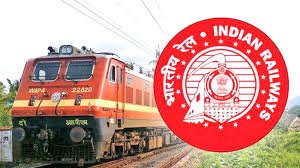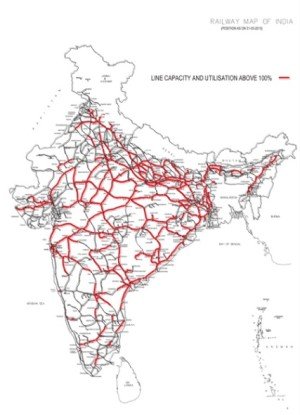The IR (Indian Railways) is the lifeline of the economy. It has played a vital role in the development and progress of India. Innumerable people of our country have benefited from the IR. The IR has been built with sweat and blood of lakhs of workers and Indian people’s money over last 165 years.
India has the fourth-largest railway system in the world. About 68,000 km of rail routes with over 99,000 km of tracks connect different parts of our vast country.
It is the only reliable and affordable means of long distance travel for crores of workers, between their place of work and their home town or village. Nearly 800 crore people travel on the Indian Railways every year or about 2.2 crore passengers every day. This is comparable to the population of countries like Australia or Sri Lanka!
The Indian Railways is equally important for transporting raw material and finished goods to all parts of our country. Over 110 crore tonnes of goods are transported on Indian rail lines every year, from food to coal to cars. Every day the IR runs over 13,000 passenger trains and nearly 8,500 freight trains from over 7,300 stations to transport people and goods.
The annual revenue of Indian Railways exceeds Rs 2 lakh crore, comparable to the largest the ten largest companies of the country. Neary two-third of the revenue of the IR comes from transport of goods.
Public money has been used to create assets of around Rs. 6 lakh crores over the years, excluding the value of huge amount of land that the IR owns. The IR owns approximately 4.81 lakh hectares of land, out of which 90% is used for track and structures including stations, colonies, etc. while 51,000 hectares of land is lying vacant.The IR own seven production units that meet the entire requirement of locomotives and coaches of the IR, at cost lower than imported rolling stock. (More details about production units and the plan to corporatize them are given separately.) The IR is the largest government owned enterprise with about 12.5 lakh employees. In addition, the IR employs around 4 lakh temporary and contract workers.
Not just the workers, but tens of thousands of people working at stalls on the stations as well as hawkers depend on the IR for their livelihood.
Successive governments have failed to invest the required capital for modernisation and expansion of the IR as per the growing needs. As much as 40 percent of the IR’s 1,219 line sections are utilised beyond 100 percent of capacity, according to a February 2015 White Paper of IR. Technically, a section using more than 90 percent of its capacity is considered saturated.
Privatisation of Indian Railways
During the last 25 years, every government, irrespective of the political party in power at the centre, has been carrying out the privatisation of Indian Railways in the name of “restructuring”, “rationalisation”, “modernisation” and lately in the name of “monetisation”. The privatisation of Indian Railways has been done stealthily in the form of outsourcing, corporatisation and PPP (Public Private Partnership, which in practice means that losses are public, to while the profits are private).
The programme of privatising Indian Railways was initiated by the Congress-led coalition government headed by Narasimha Rao in 1994, as part of the overall program of globalisation through liberalisation and privatisation.
1994: Three committees set up to recommend reforms in the IR
2001: Rakesh Mohan Committee proposed dividing railway activities into ‘core’ and ‘non-core’ and out-sourcing and corporatization of non-core activities. Outsourcing means to give out some particular activity, which has so far been carried out by the workers of Indian Railways, on contract to a private operator.
Over the years a large number of activities such as cleaning of railway stations, washing of trains, food catering, loading/unloading of bed rolls, maintenance of air conditioning of A/C coaches, etc. were outsourced. Important activities like maintenance of telecom network and IT systems were also outsourced along with running of schools, colleges and hospitals for welfare of rail workers.
2006: Privatisation of goods transport by containers.
2011: Sam Pitroda Committee on Modernisation pushed PPP.
2014: Bibek Debroy Committee recommended introduction of private passenger and goods train in competition with the Indian Railways.
2014: 17 key areas of railways opened for 100% foreign direct investment (FDI). Two high value diesel and electric locomotive manufacturing plants with foreign capital from GE of USA and Alstom of France are already under operation.
2017 – 2021:
• Announced private passenger trains on 109 profitable routes in 12 cluster from 2022.
• Announced private freight trains on the Western and Eastern Dedicated Freight Corridors from 2022.
• Plan to corporatise seven production units of railways, producing coaches and engines. Due to very strong opposition of workers and their families, it has been deferred for the time being.
• Privatisation of over 100 railways stations in the name of their redevelopment and modernisation has actively begun. Passengers to pay additional ‘user fee’ when travelling through these stations.
• Monetisation of 87 land parcels, 84 railway colonies and 4 hill railways. Monetisation means that these assets of the Indian Railways will be handed over to capitalists on long lease for making profit.
Since the Indian Railways is a Department of the Government of India, it cannot be sold directly. That is why it is being systematically broken up into different corporations and privatised part by part. About two dozen corporations have already been formed by separating activities that were previously performed by the IR and several more are being planned. Privatisation of IRCTC, IRCON, RITES, Rail Vikas Nigam, IRFC and RailTel Corporation of India has already begun through the sale of their shares.
Privatisation is a program which will ultimately lead to the transfer of all profitable activities of Indian Railways into private hands, leaving only the tracks and loss-making operations under government ownership.



